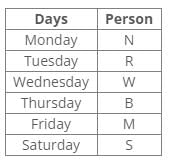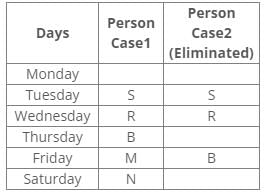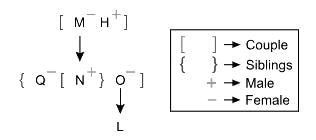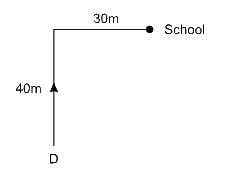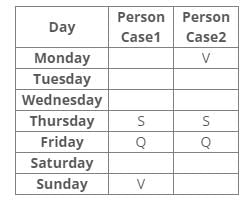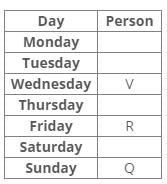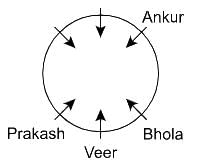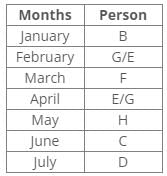MCQ: Data Sufficiency- 2 - SSC CGL MCQ
15 Questions MCQ Test - MCQ: Data Sufficiency- 2
Directions: Each of the following consists of a question and two statements numbered I and II given below it. You have to decide whether the data provided in the statements are sufficient to answer the question.
Among six persons – Rishi, Sanjay, Komal, Usha, Vijay and Tarak, each of different heights. Who is the tallest?
Statement I: Tarak is taller than only one person. Komal is taller than Rishi but shorter than Vijay.
Statement II: Rishi is taller than both Tarak and Sanjay. Vijay is not the tallest.
Statement I: Tarak is taller than only one person. Komal is taller than Rishi but shorter than Vijay.
Statement II: Rishi is taller than both Tarak and Sanjay. Vijay is not the tallest.
Directions: Each of the following consists of a question and two statements numbered I and II given below it. You have to decide whether the data provided in the statements are sufficient to answer the question.
What is Rahul's rank in the class?
Statement I: Rahul's rank is 28 less than Monika's rank.
Statement II: Aditi's rank is 42 more than Rahul's rank. Monika's rank is 12 less than Aditi's rank.
Statement I: Rahul's rank is 28 less than Monika's rank.
Statement II: Aditi's rank is 42 more than Rahul's rank. Monika's rank is 12 less than Aditi's rank.
Directions: Each of the following consists of a question and two statements numbered I and II given below it. You have to decide whether the data provided in the statements are sufficient to answer the question.
Five persons – Vikas, Lalita, Priyanka, Ramesh and David are sitting in a row facing north direction. Who among the following sits to the immediate left of Ramesh?
Statement I: Vikas sits at one of the extreme ends. Lalita sits between Vikas and Priyanka.
Statement II: Only one person sits between Priyanka and David. David does not sit to the right of Lalita.
Statement I: Vikas sits at one of the extreme ends. Lalita sits between Vikas and Priyanka.
Statement II: Only one person sits between Priyanka and David. David does not sit to the right of Lalita.
Directions: Each of the following consists of a question and two statements numbered I and II given below it. You have to decide whether the data provided in the statements are sufficient to answer the question.
Five friends – Akhil, Bina, Chetan, Dinesh and Ekta have different heights. Who is the second tallest among all?
Statement I: Akhil is taller than Chetan, who is taller than Ekta and Bina. Dinesh is not the tallest.
Statement II: Bina is taller than only Ekta. Akhil is taller than Dinesh and Chetan.
Directions: Each of the following consists of a question and two statements numbered I and II given below it. You have to decide whether the data provided in the statements are sufficient to answer the question.
Six persons – F, G, H, I, J and K, each earn a different amount of money. Who earns the maximum?
Statement I: I earns more than only two persons. J earns more than K but not maximum. G earns more than only F.
Statement II: K earns less than only two persons. G earns more than F but less than I. I earns less than K. J earns less than H.
Direction: Read the given instructions carefully and answer the questions given beside.
Six people have midterm exam on different days of the same week, starting from Monday to Saturday. Who has exam immediately after B?
I. W has exam before B. N has exam before R. No one has exam after S. M has exam after Thursday. Three people has exam between S and R.
II. N has exam immediately after M. Two people have exam before R, who has exam immediately after S. B has exam after R but not on Saturday.
Direction: Read the given instructions carefully and answer the questions given beside.
How L is related to Q?
I. N is the son of L, who is married to O. L has only one child. H is the father-in-law of N. O is the mother-in-law of Q.
II. H has only one son and one daughter, one of which is N. Q is the sister of N, who is the son of M. M is the mother-in-law of O, who is the mother of L.
Direction: Read the given instructions carefully and answer the questions given beside.
In which direction is D’s home from the school?
I. D moved a distance of 40m towards north. From there he turns to the right and walked for 30m and reached school.
II. D is facing south. He turns right and walk for 100m. After that he turned to the left walk for 50m and reach home.
Direction: Read the given instructions carefully and answer the questions given beside.
Seven friends P, Q, R, S, T, U and V visits zoo on seven different days of the same week starting from Monday. Who visits the zoo on Sunday?
I. S visits the zoo immediately before Q, who visits on Friday. Two persons visit between S and V.
II. Only two people visits zoo after R. V visits zoo two days before R. Three people visits zoo between V and Q.
Direction: Read the given instructions carefully and answer the questions given beside.
Seven friends are watching football match facing north side. Who sits at the extreme right end?
I. S sits third to the right of N and third to the left of M.
II. X sits in the middle of the line. Y sits second to the right of X. Z sits fifth to the left of W, who is the neighbor of Y.
Six persons – Veer, Prakash, Bhola, Shiv, Ankur and Bhanu were sitting around a circular table facing towards the centre. Who was sitting to the immediate right of Bhanu?
Statement I: Ankur was sitting second to the right of Veer, who was sitting to the immediate left of Bhola. Prakash was sitting second to the left of Bhola.
Statement II: Shiv was sitting to the immediate right of Ankur, who was sitting second to the right of Veer. Prakash was sitting second to the left of Bhola, who is to the immediate left of Ankur.
Seven persons B, C, D, E, F, G and H are born on seven different months of a year starting from January, but not necessarily in the same order. Who was born in July?
Statement I: C was born just before D. Only two persons are born after H. Three persons are born between H and B. F was born two months after B.
Statement II: E was born in April. D was born after C. Two persons are born between E and B. B was not born in July. C was born one of the months after May.
Who is oldest among Priya, Kamal, Johny, Rohit, Suresh and Tinku?
Statement I: Rohit is older than Priya and Johny. Rohit is younger than Kamal. Suresh is older than only Tinku.
Statement II: Suresh is older than Johny but younger than Priya. Tinku is older than only Rohit. Priya is not the oldest.
Direction: Read the given instructions carefully and answer the questions given beside.
Which code word stands for ‘Time’ in the coded sentences ‘oqa ahw’ which means ‘be careful’?
I. In the same code language ‘dnj msk ahw swe’ means ‘May be next time’
II. In the same code language ‘vnm msk qqa oqa’ means ‘Careful you are next’
Direction: Read the given instructions carefully and answer the questions given beside.
The conclusion H < D is definitely followed by which of the following statements?
I. C = X ≤ D ≥ R
II. R > Z = O > H







